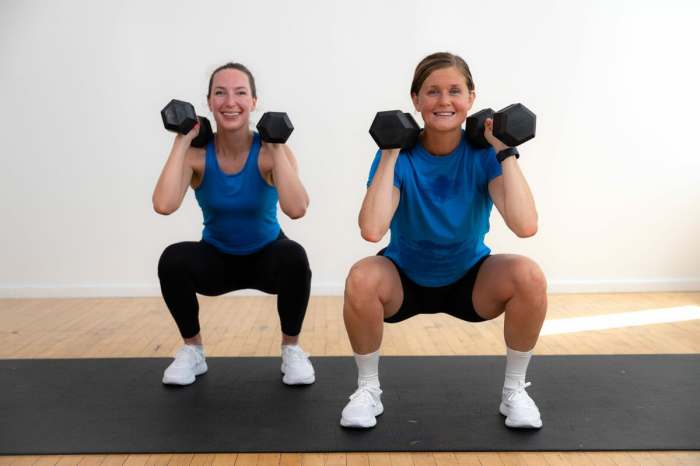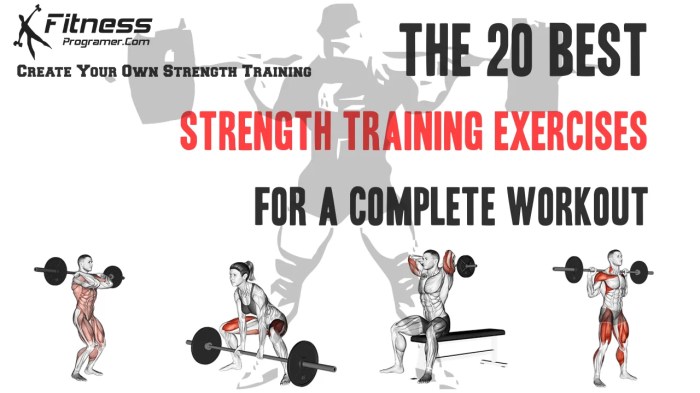Strength training exercises are the key to unlocking your full potential in the gym. Get ready to dive into a world of gains and strength like never before with this ultimate guide.
From bodyweight exercises to weightlifting routines, this comprehensive overview will equip you with the knowledge needed to crush your fitness goals.
Strength Training Exercises

Strength training exercises are an essential component of any fitness routine, offering a wide range of benefits for overall health and well-being. Incorporating these exercises into your workout regimen can help improve muscle strength, endurance, bone density, metabolism, and even boost your confidence.
Types of Strength Training Exercises
- Bodyweight Exercises: Examples include push-ups, squats, lunges, and planks. These exercises use your body weight as resistance and are great for beginners.
- Weightlifting: This includes exercises like deadlifts, bench presses, and bicep curls using dumbbells, barbells, or weight machines. Weightlifting helps build muscle mass and strength.
Importance of Proper Form and Technique
It is crucial to maintain proper form and technique when performing strength training exercises to prevent injuries and maximize results. Focus on posture, breathing, and controlled movements to target the right muscles effectively.
Tips for Beginners
- Start with lighter weights or resistance to master the movements and avoid strain.
- Warm up before each session and cool down afterwards to prevent muscle soreness.
- Consult a fitness trainer for guidance on proper form and personalized workout plans.
- Gradually increase the intensity and challenge as you progress to keep seeing improvements.
Bodyweight Exercises

Bodyweight exercises are a great way to build strength and muscle without the need for any equipment. They utilize your own body weight as resistance, making them accessible to everyone regardless of their fitness level.
List of Effective Bodyweight Exercises
- Push-ups
- Squats
- Lunges
- Planks
- Mountain Climbers
- Burpees
- Pull-ups (using a bar or sturdy ledge)
- Tricep Dips
- Glute Bridges
Modifying Bodyweight Exercises
Bodyweight exercises can be modified to target different muscle groups by changing the angle of your body, adjusting the tempo of the movement, or incorporating variations such as single-leg or single-arm movements. For example, doing incline push-ups can target more of the upper chest, while doing close-grip push-ups can focus on the triceps.
Advantages and Disadvantages of Bodyweight Exercises vs. Weights
Advantages of bodyweight exercises include their convenience, cost-effectiveness, and ability to improve functional strength. On the other hand, using weights allows for progressive overload and can lead to quicker muscle gains. However, weights may require more equipment and supervision to ensure proper form.
Sample Bodyweight Workout Routine
- 10 Push-ups
- 15 Squats
- 20 Lunges (10 per leg)
- 30-second Plank
- 20 Mountain Climbers (10 per leg)
- 10 Burpees
- 5 Pull-ups or 10 Tricep Dips
- 15 Glute Bridges
Weightlifting Exercises
Weightlifting exercises are crucial for building strength and muscle mass. There are two main types of weightlifting exercises: compound and isolation exercises.
Compound exercises involve multiple muscle groups and joints working together in a coordinated movement. These exercises are efficient and effective for building overall strength and muscle mass. Examples of compound exercises include squats, deadlifts, bench press, and overhead press.
Isolation exercises, on the other hand, target a specific muscle group and involve movement only at one joint. These exercises are great for targeting individual muscles and addressing muscle imbalances. Examples of isolation exercises include bicep curls, tricep extensions, and calf raises.
Key Weightlifting Exercises for Major Muscle Groups
- Squats: Great for building lower body strength, targeting the quads, hamstrings, and glutes.
- Deadlifts: Excellent for overall strength development, focusing on the back, glutes, and hamstrings.
- Bench Press: Essential for building upper body strength, targeting the chest, shoulders, and triceps.
Importance of Progressive Overload in Weightlifting
Progressive overload is crucial in weightlifting for continuous strength gains. This principle involves gradually increasing the weight, reps, or sets over time to challenge the muscles and stimulate growth. Without progressive overload, the muscles will not adapt and grow stronger.
Safety Tips and Precautions for Weightlifting Exercises
- Always warm up before starting your weightlifting routine to prevent injuries.
- Focus on proper form and technique to avoid strain and reduce the risk of injury.
- Start with lighter weights and gradually increase the load as you progress to prevent overexertion.
- Listen to your body and rest when needed to allow for muscle recovery and growth.
- Consider working with a certified trainer to ensure you are performing exercises correctly and safely.
Equipment for Strength Training: Strength Training Exercises
To effectively engage in strength training, whether at home or in a gym, it is important to have the right equipment. The equipment you choose can greatly impact the effectiveness of your workout routine. Here, we will discuss the essential equipment needed for strength training, the pros and cons of using machines versus free weights, a comparison of resistance bands, dumbbells, and barbells, and how to choose the right weight or resistance level for different exercises.
Essential Equipment for Strength Training
- Barbell and weight plates
- Dumbbells
- Resistance bands
- Bench press
- Pull-up bar
- Kettlebells
- Medicine ball
Machines vs. Free Weights
Using machines for strength training provides guided movements and stability, making it ideal for beginners. However, free weights engage more muscles for stabilization and offer a more functional workout.
Comparison of Resistance Bands, Dumbbells, and Barbells, Strength training exercises
- Resistance Bands: Great for mobility exercises and easy to pack for travel. Offer variable resistance levels based on band color.
- Dumbbells: Versatile for various exercises and suitable for unilateral training. They come in different weights for progression.
- Barbells: Ideal for compound exercises like squats and deadlifts, allowing you to lift heavier weights and build overall strength.
Choosing the Right Weight or Resistance Level
When choosing the weight or resistance level for strength training exercises, start with a weight that allows you to perform 8-12 repetitions with proper form. Gradually increase the weight as you get stronger to continue challenging your muscles.

